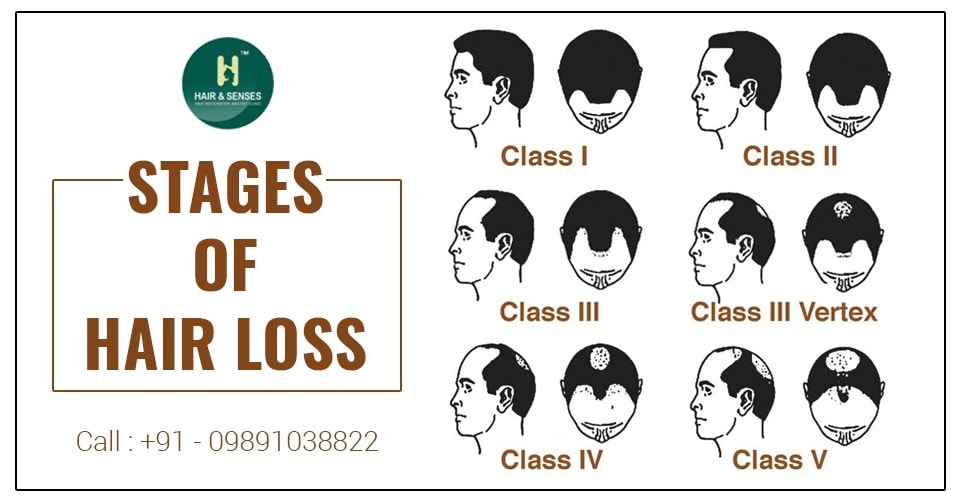Stages of Hair Loss
March 10, 2018 | By Dr. Sangay Bhutia (Hair Transplant Specialist in Delhi)

Everyone loses hair, everyday, but it’s not always a cause of concern. An average person sheds about 50-100 strands of hair everyday. But if there is more shedding than that, it’s a cause of concern.
Hair fall is often induced by stress, nutritional deficiencies, anaemia, hypothyroidism, lupus, or crash dieting, and sometimes people start losing hair in clumps and shed a lot more than normal. If you notice that happening to you, or that there are bald spots developing on your scalp, it calls for attention. Hair fall can be indicative of something that is wrong with the body and should definitely not be ignored.
While hair fall induced by these causes is not permanent, and in most cases will come back with the use of right treatment but there is also permanent hair fall.
The most common type of male hair loss is called androgenetic alopecia, often referred to as "male pattern baldness" or "male pattern hair loss". Male pattern hair loss is responsible for hair loss in about 90% of men. It can begin as early as the teens or twenties.
Stages of Hair Loss
The generally accepted method to access the degree or extent of hair loss is the Norwood-Hamilton scale. Here are the various stages of hair loss on the Norwood scale.
Stage 1: The first stage is characterised by minor recession of the hair line. It does not require immediate attention, unless you have family history of baldness, or Androgenic Alopecia. Although, you might want to start avoiding things that might induce hair loss, like smoking, eating unhealthy, crash dieting etc.
Stage 2: This stage is characterised by mild hair loss or thinning in the front of the head. This is when the initial signs of balding start to show.
Stage 3: This stage, baldness starts to become more evident. For most men, this stage means there will be deep symmetrical recession at the temples. There can be thinning of the hair at the crown of the head, in this stage.
Stage 4: This stage means that the hair loss on the crown is quite evident. There is often a bridge of hair separating hair loss above the temples and on the crown. The sides and back of the scalp will be sufficiently covered with hair.
Stage 5: At this stage, the bridge extending between the front and the crown will become thinner. And hair loss at the crown and front will be distinct. Although, there is still hair on the back and sides of the head.
Stage 6: The bridge between the crown and front will be left with only sparse growth. The front and the crown spots of baldness will be almost conjoined. There is hair loss on the sides as well.
Stage 7: This is the most advanced stage of hair loss, and is characterised by thin bands of hair left on the back and sides of the head.
If you are noticing patterned hair loss, it is bet to see a specialist, and not self diagnose, even if the pattern looks predictable. Pattern baldness can be diagnosed by a specialist, on the basis of appearance, medical history and lifestyle. The idea behind a diagnosis is that it can rule out other reasons for hair loss.
Also, if you are experiencing pattern hair loss, it is irreversible, but it is not the end of the world. Hair transplant today is more advanced than ever and a good surgeon is all it takes to restore your hair.
Currently, there are two widely used methods of hair restoration used by surgeons – Follicular Unit Transplantation (FUT) and Follicular Unit Extraction (FUE). FUE is a minimally invasive technique. It involves harvesting hair follicles one by one by using micro punches from the patient’s donor site, the back and sides of the head, and implanting them onto the thinning or bald areas. FUE is ideal for patients with male pattern baldness and involves no incision and heals quickly.
FUT involves extracting a strip of scalp from the back or sides of the head and dissecting it into individual grafts, which are then transplanted on the bald spots. The difference between FUE and FUT is the method of extraction of follicles, while the rest of the procedure remains the same.
